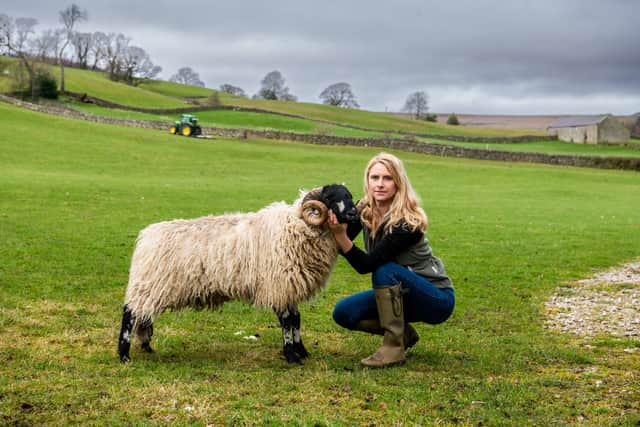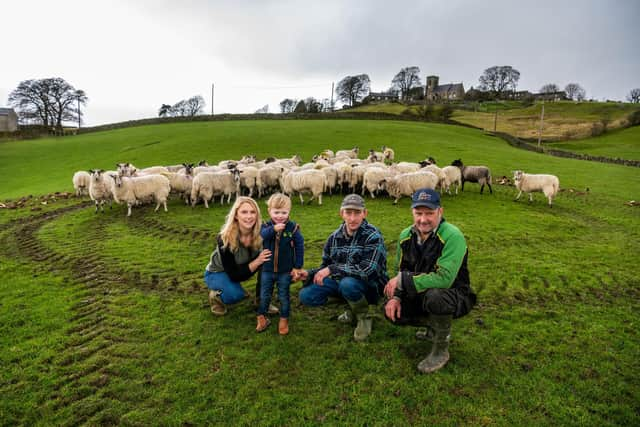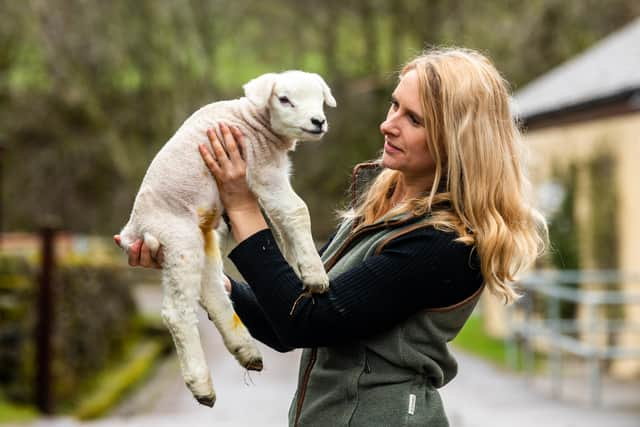Farm of the Week: Latest generation in line of show champions from Nidderdale
Heather Challis of Halfway House Farm between Lofthouse and Middlesmoor in Upper Nidderdale had her most successful showing year to date with her Dalesbreds in 2022 picking up reserve champion male at the Great Yorkshire Show, breed champion at Ripley and Wensleydale, reserve champion male at Kilnsey, and breed reserve & champion local at Nidderdale, but Heather said the one that meant the most came at Pateley Bridge.
“My granddad David loved his Dalesbreds and I’ve always had this photo of him at Nidderdale Show with his best gimmer lamb. I took 20 sheep to Pateley last year and won seven cups but winning his cup, the one with his name on it, for the first time was really special. I’d been trying to win it since I started out showing as a young girl. I was really happy.
Advertisement
Hide AdAdvertisement
Hide Ad“Dalesbreds have always been my favourite sheep and we have a flock of 250 breeding ewes, of which 50 are mine. I buy and breed my own to a high standard to show them and my Dalesbred tups now attract a lot of interest at the breed sales at Bentham livestock market.


Heather admits it wasn’t always the case and that she still feels a bit like a newcomer even now, compared to those who have been showing Dalesbreds for decades, although she has now had hers for fifteen years.
“I’ve had my own since I was 12 years old. I’ve stuck at it and I’m doing okay now, regularly producing good tup lambs and ewe lambs to improve my own flock and also to sell to other breeders.
“I’m nowhere near achieving the record Dalesbred breed prices but the first tup I ever sold at Bentham made £1300 in 2018 and the year after in 2019 I got reserve breed champion at the show and sale where my shearling tup made £2600. That’s the best price I’ve received so far.
Advertisement
Hide AdAdvertisement
Hide AdHeather farms alongside her father Neil, her uncle Carl and her mum Anne Challis at Halfway House, tenanted from Middlesmoor Estate; and Studfold Farm just half a mile away where her mum and her mum’s brother Ian Walker run The Nidderdale Experience, an award-winning enterprise in its own right that includes trails, glamping and a camping and caravan site.


“We farm around 70 acres at Halfway House and around 300 acres overall, including Studfold and other land,” said Heather. “We have grazing rights on the moor with other sheep farmers from April to November.
“As well as the 250 Dalesbred ewes we also have a flock of 300 Dales Mule ewes and I also have a flock of 40 pure Texels. We run a herd of 100 Limousin-cross-Friesian suckler cows that are put to either the Limousin or British Blue bull that we either buy up in Carlisle or privately. Our store lambs go to Skipton livestock market, the cattle go to Pateley Bridge and the Dalesbreds are sold at Bentham in the breed sales or privately.
This is the busiest time of year at Halfway House as lambing and calving takes place through March to May.
Advertisement
Hide AdAdvertisement
Hide Ad“The Texels started lambing in March. I breed to raise quality tups and females; March is


also when the sucklers started calving and carry on through to May. The Dalesbreds and Dales Mules are due to start from next week, which is quite late but we don’t get much grass up here and it’s important that when they’re lambed they can get back out to it.
“Our Dalesbreds are hefted to the moor and are normally kept on there, apart from lambing, until they are three-shear, which is when they become draft ewes to go to the Bluefaced Leicester tup to produce the Dales Mule.
“The Dales Mule is really hardy, just like the Dalesbred. The key difference between the Dalesbred and Dales Mule versus the Swaledale and the North of England Mule is that the Dalesbred fleece is longer and hardier than the Swaledale and not as tight, and it follows that is the same with the Dales Mule as it is what gets bred into the lamb. We used to keep Mashams that would last longer than any Mule but fashion changes and if you can’t achieve a price you have to change with the rest.
Advertisement
Hide AdAdvertisement
Hide AdHeather said that maintaining the flocks of Dalesbreds and Dales Mules is done largely by keeping gimmer lambs as replacements.
“We normally keep all our Dalesbred gimmer lambs that go onto the moor as hoggs so they get hefted to the moor at a young age. Any Dalesbred tups I think are good enough I will normally tag and keep and if a ewe has a good tup lamb it probably won’t go to the moor. It will get special treatment. Some I will sell as teaser tups rather than going into the food chain.
“Other tup lambs that I don’t consider good enough will go to Skipton for the horned lamb sale as stores at 30-32 kilos.
“The sheep come off the moor fairly fit and just grass fed. I’m trying to avoid concentrates the way prices of everything has gone.
Advertisement
Hide AdAdvertisement
Hide AdHeather said that getting the ewes tupped in autumn and winter proved more difficult in 2022 after the arid summer.
“The grass had been so hot that it didn’t have the nutrients in it and that had an effect on the ewes when flushing them and trying to get them tupped. Mine tupped quite late this year compared to other years.
Nutrients and nutrition were a course Heather had been interested in going down after studying at Harper Adams for her degree in agriculture.
“In my final year I specialised in nutrition and farm business and enjoy the nutritional side. I’d wanted to work for a feed company but my ties to the farm meant I couldn’t commit to a full-time role elsewhere.
Advertisement
Hide AdAdvertisement
Hide AdHeather has her hands well and truly full at present looking after her own stock, working alongside her father and uncle, plus her great uncle Brian, and also works on three other local farms to supplement her income, while also looking after her three-year old son Billy and her four corgis. Her partner Sam is an architect and farms in Coverdale and has suckler cows and Swaledale sheep.
Heather said Billy is her major helper.
“He loves anything to do with animals, he’s tractor mad, he loves the dogs and especially the corgis.
“I got my first corgi puppy while at university. I hadn’t told mum I was bringing it home and it went from having to live in the kennel to ‘oh, it can stay in the back kitchen’ and now sleeps next to her bed, so she kept it. I got another one, Jerry. Mum’s dog Purdy had a litter of puppies. I kept a female and bought another this year. They are fantastic little dogs, they work around farm, they go mole-ing a lot.